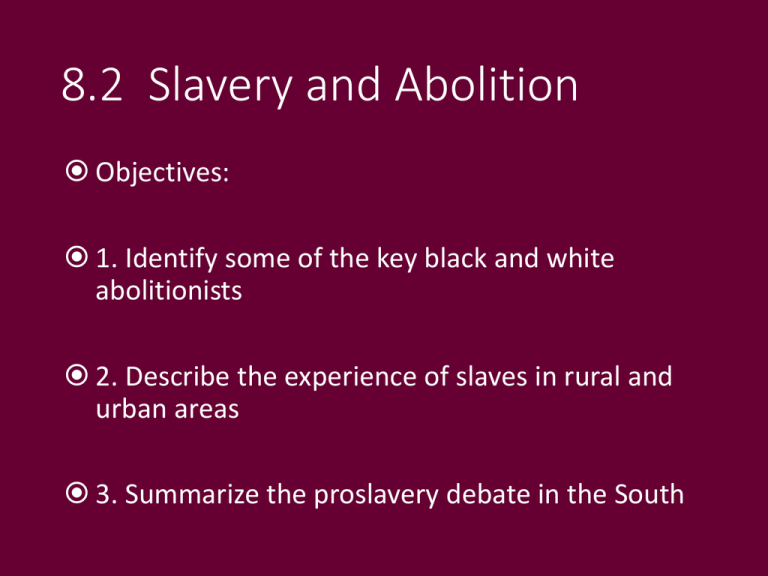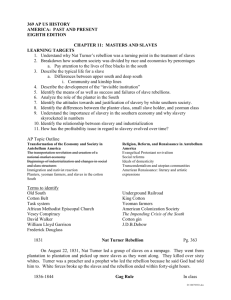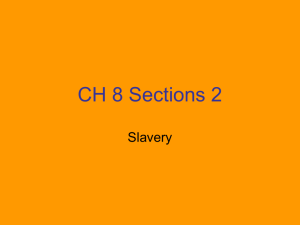
8.2 Slavery and Abolition
Objectives:
1. Identify some of the key black and white
abolitionists
2. Describe the experience of slaves in rural and
urban areas
3. Summarize the proslavery debate in the South
Abolitionists Speak Out
• Many began to speak out in support of abolition
• Demanded immediate emancipation
William Lloyd
Garrison
• Author of the
Liberator
• Demanded
emancipation
“I am in earnest-I will not equivocate-I will not
excuse-I will not retreat a single inch-AND I WILL
BE HEARD.”
David Walker
• Urged violent
uprising
• Found dead
outside of his
printing office
“The man who would not
fight…ought to be kept with all
his children or family, in slavery
or in chains to be butchered by
his cruel enemies.”
Frederick Douglass (1817-1895)
Escaped from slavery in Baltimore
Moved North and began preaching
against slavery
Began The North Star
“I have been frequently asked how I felt
when I found myself in a free state….It
was a moment of the highest
excitement I ever experienced…. This
state of mind, however, very soon
subsided; and I was again seized with a
feeling of great insecurity and
loneliness. I was yet liable to be taken
back, and subjected to all the tortures
of slavery. This in itself was enough to
damp the ardor of my enthusiasm.”
http://www.pbs.org/wgbh/aia/part4/images/4fred16m.jpg
Compare and Contrast
• Garrison
•
• Douglas
Walker
Life of a Slave
Slaves are increasingly valuable
Speak English
Equal amount of men and women
Urban and Rural slave
○ What is the difference?
Slaves are increasingly sold “down the river” from soil-depleted
areas.
○ Auctions separate families.
Beatings were common
Map: The Internal Slave Trade, 1810-1860
Copyright © Houghton Mifflin Company. All rights reserved.
Torture Mask, woodcut, 1807
Torture Mask, woodcut, 1807
The laws of southern states had long
stipulated that masters could use
whatever means they deemed necessary
to prevent slave runaways and insolence.
In the early 1800s, some planters
adopted this so-called restraining mask
to punish slaves. (Library of Congress)
Copyright © Houghton Mifflin Company. All rights reserved.
http://www.assumption.edu/users/lknoles/slavebroadside.jpg
Slave Revolts and Resistance
• Slaves resist through sabotage and slowdowns
• 1831: Nat Turner leads revolt in Virginia.
Turner and 50 followers attack 4 plantations and kill 50
whites.
All Revolts are suppressed quickly and violently.
Nat Turner, artist unknown
No pictures of famed slave revolt leader Nat Turner are
known to exist, but this nineteenth-century painting
illustrates how one artist imagined the appearance of Turner
and his fellow conspirators. White southerners lived in terror
of scenes such as this and passed severe laws designed to
prevent African Americans from ever having such meetings.
(Granger Collection)
COMPARE AND CONTRAST
FREE BLACK
URBAN SLAVES
RURAL SLAVES
Southern Support for Slavery
• “Cotton is King” – Economy depends on
slavery
• South advances theory that slavery
“civilizes” Africans, compares slave’s quality
of life to “wage slaves” in the North
• "I firmly believe," said Governor J. H.
Hammond, "that American slavery is not
only not a sin, but especially commanded
by God through Moses, and approved by
Christ through his apostles.
•
•
“In all social systems there must be a
class to do the menial duties, to perform
the drudgery of life. . . . It constitutes the
very mudsill of society.”
“Design for Mastery” – Drew Gilpin Faust
James H. Hammond
SC politician and
planter
Abolitionism
BEFORE 1820 antislavery societies are more numerous in
the antebellum South. Slave revolts end Southern
toleration of abolition.
1835 Congress forbids use of mail to send abolitionist
material through the mail.
1836 House of Reps passes the “gag rule,”
○ John Quincy Adams defeats this in court after 8 yrs.
South advances theory that slavery “civilizes” Africans,
compares slave’s quality of life to “wage slaves” in the
North
“In all social systems there must be a class to do the
menial duties, to perform the drudgery of life. . . . It
constitutes the very mudsill of society.”
Northern abolitionists begin to call for emancipation –
freeing of all slaves – not just banning slavery in the North
TERMS
OBJECTIVES
Objectives:
1. Identify some of the key black and
white abolitionists
2. Describe the experience of slaves
in rural and urban areas
3. summarize the proslavery debate
in the South
TERMS
• Abolition
• William Lloyd Garrison
• Emancipation
• David Walker
• Frederick Douglass
• Nat Turner
• Antebellum
• Gag Rule





